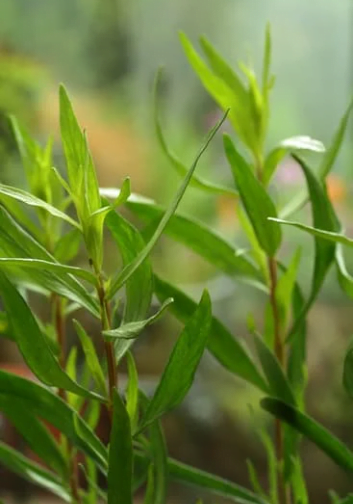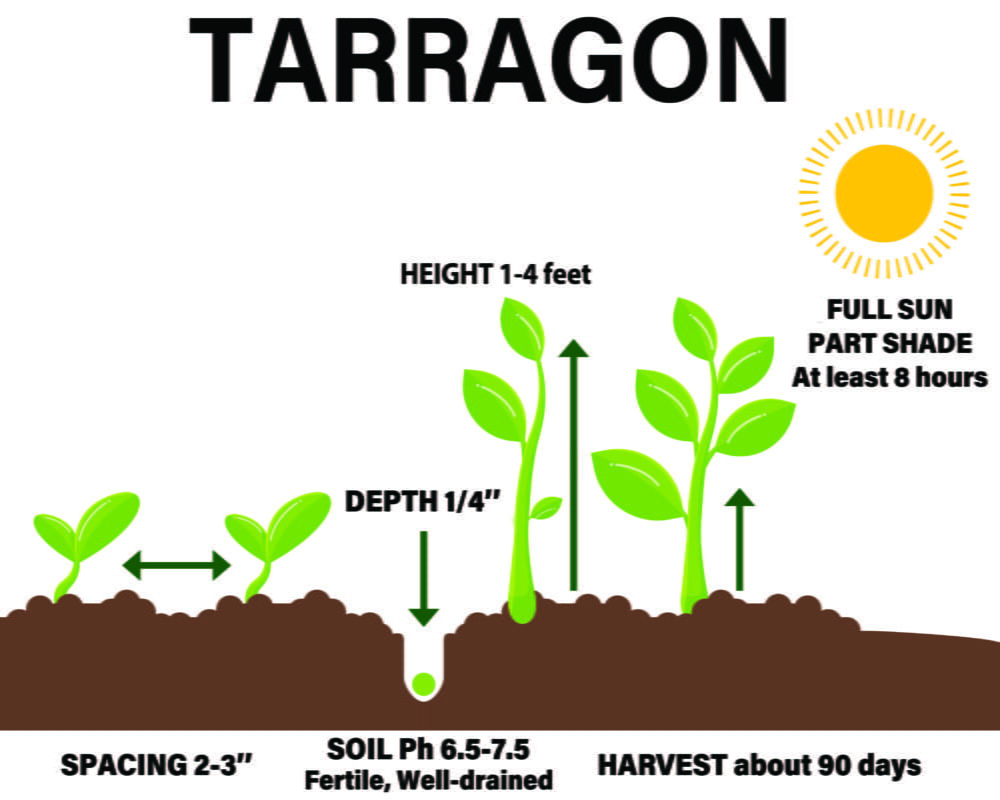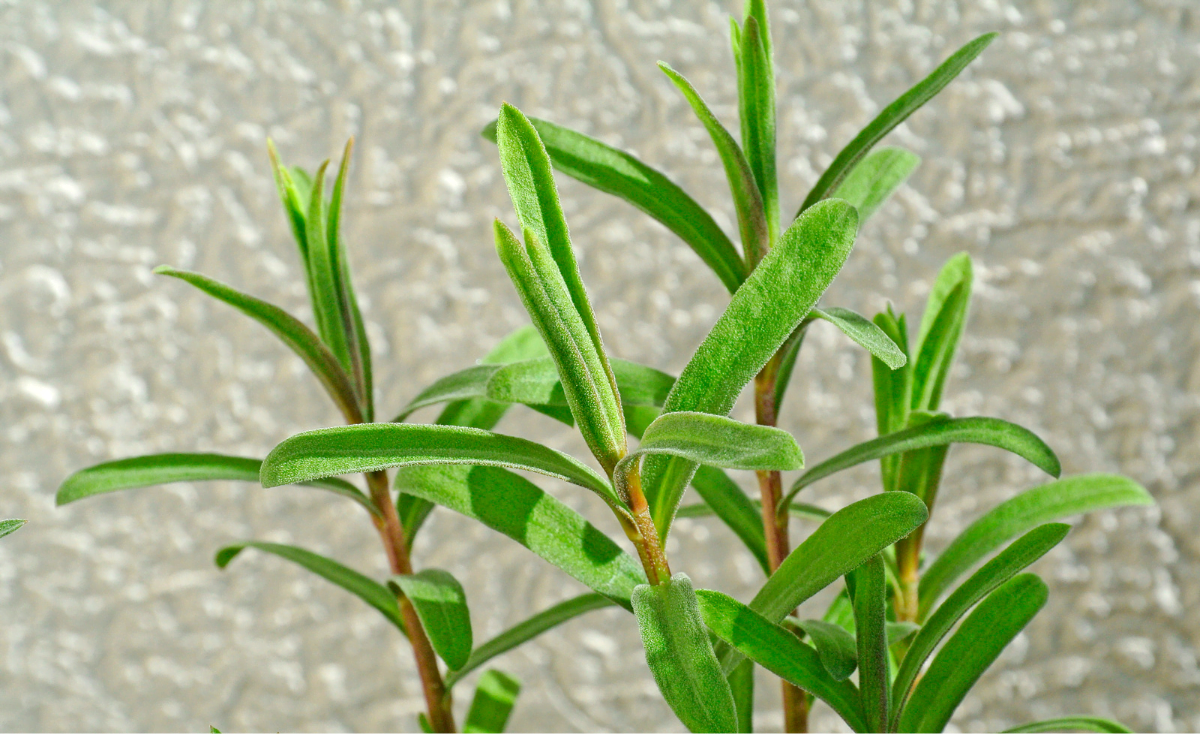Tarragon, also known as Estragon, is a perennial herb that you may be surprised to learn is part of the Sunflower family. The plant has long, light green leaves and can grow to be a few feet high. Just one plant will generate a generous amount of leaves to pick.Tarragon is native to mild European regions. It’s hardy and easy to grow in a sunny or partially shaded spot in well-drained soil. It thrives in spring temperatures and doesn’t do well in overly hot climates.

| Botanical Name | Artemisia dracunculus (Sativa subspecies) |
| Common Name | Estragon |
| Plant Type | Perennial herb |
| Mature Size | 24 inches |
| Sun Exposure | Part Sun/Part Shade |
| Soil Type | Sandy, well-drained |
| Soil pH | Neutral (6.5 to 7.5) |
| Bloom Time | Summer |
| Flower Color | Light green leaves |
| Hardiness Zones | 4 and warmer |
| Native Area | Temperate Europe and Asia |

When to Plant?
This will be determined by your planting zone. There is a final frost date for each area. As a result, you can plan your gardening activities around this date. Check our Frost Dates Across North America: First & Last Frost Dates Chart. However, the date will not be the same for every plant.
How to Plant
Tarragon is best planted in early spring, after the last spring frost. First, tarragon can be planted in a container with a diameter of 5 – 6″. When the roots are completely entwined with an earthen ball and even appear outward through the holes in the pot’s bottom, you can transfer the tarragon into a larger container.
It’s usually easier to sow about four to six seeds per pot using moist, composted potting soil. Cover the seeds lightly and keep them in low light at room temperature.
Once seedlings begin to sprout or reach a couple of inches tall, they can be thinned down to one plant per pot.

Tarragon has a substantial nutritional profile with minerals, vitamins A, B, C, and flavonoids. Tarragon is an important herb in French cuisine. Its anise-like or licorice flavor is perfectly paired with seafood, chicken, eggs, and tomatoes. This herb is cold-resistant, heat-resistant, and drought-tolerant. Thus, it is a great choice for beginning home gardeners who may grow tarragon either in a sunny windowsill or outside. Companions – Eggplant. Often planted with thyme and other low-growing herbs.
How to Cultivate
Soil – Tarragon should be located in well-drained, fertile soil.
Sun – Tarragon prefers full sun but will tolerate partial shade.
Spacing – 2 – 3″
Water – While helping new tarragon seedlings get established, keep the soil evenly moist
Fertilizer – Not usually required.
Frost tolerant – tarragon can survive temperatures to -20°F.
How to Harvest
Once your tarragon plant has grown at least 10 inches tall, you may begin harvesting.
Choose small stems to trim with scissors.
Harvest fresh sprigs throughout the growing season.
While tarragon leaves are best enjoyed fresh, you can freeze the leaves or dry them.
If left to dry for too long, though, the leaves lose their flavor, so be careful.
As soon as the leaves are dry, store them in airtight containers.
Hydroponics
Germination: To germinate tarragon seeds, you can place them in a wet paper towel or seed-starting mix until they sprout. Once they have sprouted, you can transplant them to your hydroponic system.
pH range: Tarragon prefers a slightly acidic pH range of 6.0-6.5. It’s important to regularly monitor the pH level of your hydroponic system and adjust it as needed to ensure optimal growth.
EC: The electrical conductivity (EC) level should be maintained at around 1.0-1.8 mS/cm for hydroponic tarragon. This helps to ensure that the plants receive the right amount of nutrients.
PPM: The parts per million (PPM) for hydroponic tarragon should be around 600-1200 ppm. This measures the concentration of nutrients in the water solution.
Humidity: Tarragon prefers a moderate to high humidity level of around 50-70%. To maintain the proper humidity level in your hydroponic system, you can use a humidifier or misting system.
Light hours: Tarragon requires around 12-16 hours of light per day to grow and thrive. You can use LED grow lights or other types of grow lights to provide the necessary light.
Temperature air: The ideal temperature range for tarragon is between 18-25°C (65-77°F). It’s important to maintain a consistent temperature within this range to avoid stressing the plants.
Temperature water: The recommended water temperature range for tarragon is between 18-22°C (65-72°F). Again, it’s important to maintain a consistent temperature within this range to avoid stressing the plants.
By following these guidelines, you should be able to successfully grow Tarragon hydroponically. Good luck!
Common Pests and Diseases
Tarragon rust (Puccinia dracunculina)
Symptoms: Yellow or white spots on underside of leaves; bright orange or yellow pustules on underside of leaves; leaves may turn yellow; growth is stunted and plant may become stunted.
Cause: Fungus
Management
Remove all crop debris andd infected leaves; avoid the use of oveerheadd irrigation or water in the morrning to allow plant foliage to dry durring the day; ensure plants are well spaced to promote good air circulatioon around plants.



